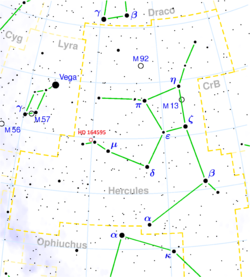HD 164595
| Observation data Epoch J2000 Equinox J2000 | |
|---|---|
| Constellation | Hercules[1] |
| Right ascension | 18h 00m 38.894s[2] |
| Declination | +29° 34′ 18.92″[2] |
| Apparent magnitude (V) | 7.07[1] + 12.538[3] |
| Characteristics | |
| Spectral type | G2 V[4] + M2.5 V[5] |
| B−V color index | 0.635±0.005[1] |
| Absolute magnitude (MV) | +4.81[1] |
| Details | |
| HD 164595 A (primary) | |
Gyr | |
| HD 164595 B (secondary) | |
| Mass | 0.455±0.046[3] M☉ |
| Radius | 0.464±0.018[3] R☉ |
| Temperature | 3,648±21[3] K |
| Rotation | 43.486848 d[10] |
| Database references | |
| SIMBAD | data |
HD 164595 is a wide
The
The secondary member, component B, is a magnitude 12.5
Planetary system
HD 164595 has one known exoplanet, HD 164595 b, which orbits HD 164595 A every 40 days.[19][20] It was detected with the radial velocity technique with the SOPHIE echelle spectrograph. Since the inclination of the orbital plane is unknown, only a lower bound on the mass of the object can be determined. The exoplanet has a minimal mass equivalent of 16 Earths.[19]
| Companion (in order from star) |
Mass | Semimajor axis (AU) |
Orbital period (days) |
Eccentricity | Inclination | Radius |
|---|---|---|---|---|---|---|
| b | >0.0516±0.00856 MJ | 0.23 | 40.00±0.24 | 0.088+0.12 −0.066 |
— | — |
Signal observation and SETI
In 2016, HD 164595 briefly attracted media attention after it was reported that a possible
On 15 May 2015, a brief, single radio signal at 11 GHz (2.7 cm wavelength)[22] was observed in the direction of HD 164595 by a team led by N. N. Bursov[23] involving Claudio Maccone at the RATAN-600 radio observatory. The signal may have been caused by terrestrial radio-frequency interference or gravitational lensing from a more distant source.[24][25] It was observed only once (for two seconds), by a single team, at a single telescope, giving it a Rio Scale[26] score of 1 (insignificant) or 2 (low). Discussions in the media from 29 August 2016 onwards featured speculation that the signal could be caused by an isotropic beacon from a Type II civilization.[27]
The senior astronomer of the
SETI and
The
See also
- Arecibo message, a three-minute-long message sent into space
- HD 162826
- Tabby's Star (KIC 8462852)
- Wow! signal, possible alien radio signal
Footnotes
- ^ An exact solar twin would be a G2V star with a 5778 K temperature, be 4.6 billion years old, with the correct metallicity and a 0.1% solar luminosity variation.[18][17]
References
- ^ S2CID 119257644.
- ^ S2CID 244398875. Gaia DR3 record for this source at VizieR.
- ^ S2CID 19269312. 64.
- ^ doi:10.1086/110986.
- ^ S2CID 53135130. A128.
- ^ S2CID 52952408.
- ^ S2CID 119491061, A72.
- ^ S2CID 118507965.
- ^ S2CID 119111150.
- ^ . 166.
- ^ "HD 164595". SIMBAD. Centre de données astronomiques de Strasbourg. Retrieved 28 December 2023.
- ^ S2CID 119260219.
- ISBN 0-933346-84-0.
- S2CID 2603568.
- ^ S2CID 119111150.
- S2CID 119205608.
- ^ a b Williams, D. R. (2004). "Sun Fact Sheet". NASA. Retrieved 23 June 2009.
- ^ "Solar Variability and Terrestrial Climate - NASA Science". NASA. Retrieved 8 January 2013.
- ^ a b "HD 164595 b Confirmed Planet Overview Page". NASA. Retrieved 31 August 2016.
- S2CID 119181352.
- ^ HD 164595 b on exoplanet.eu
- ^ a b Berger, Eric (29 August 2016). "Ars Technica". Ars Technica. Ars Technica. Retrieved 29 August 2016.
- ^ Gilster, Paul (27 August 2016). "An Interesting SETI Candidate in Hercules". Centauri Dreams. Retrieved 29 August 2016.
- ^ Bursov, N.; et al. (2016). "SETI observations on the RATAN-600 telescope in 2015 and detection of a strong signal in the direction of HD 164595". IAA SETI Permanent Committee. Guadalajara, Mexico.
- KurzweilAI. 29 August 2016. Retrieved 31 August 2016.
- ^ "Rio scale calculator". AV Sport. Archived from the original on 2 September 2016. Retrieved 29 August 2016.
- ^ Seemangal, Robin (29 August 2016). "Not a Drill: SETI Is Investigating a Possible Extraterrestrial Signal From Deep Space". Observer. Retrieved 29 August 2016.
- ^ a b "They're not saying it's aliens, but signal traced to sunlike star sparks SETI interest". GeekWire. 29 August 2016. Retrieved 29 December 2023.
- ^ "'Leaked' space signal report has SETI groups scrambling". SFGate. 29 August 2016. Retrieved 29 December 2023.
- University of Berkeley. Retrieved 29 December 2023.
- ^ Croft, Steve; et al. "Breakthrough Listen Follow-up of a Transient Signal from the RATAN-600 Telescope in the Direction of HD 164595" (PDF). University of Berkeley. Retrieved 29 December 2023.
- ^ "Monitoring of the continuum of SETI candidates with RATAN-600 (SAO RAS official comment)". Sternberg Astronomical Institute. Retrieved 29 December 2023.

